Hemorrhagic Ovarian Cyst: A Sonographic Perspective
When a graafian follicle ruptures to release an oocyte, it is transformed into a corpus luteum. The corpus luteum is lined by a layer of granulose cells which rapidly become vascularized; some of these thin-walled vessels can rupture. This causes bleeding into the corpus luteum, resulting in the formation of a hemorrhagic cyst of the ovary.
When internal hemorrhage occurs into functional cysts of the ovary it is called a hemorrhagic ovarian cyst. This occurs most commonly into a corpus luteal cyst, and less often in a follicular cyst.
Pathophysiology: Mechanism of Formation of Hemorrhagic Cysts
When a graafian follicle ruptures to release an oocyte, it is transformed into a corpus luteum. The corpus luteum is lined by a layer of granulose cells which rapidly become vascularized; some of these thin-walled vessels can rupture. This causes bleeding into the corpus luteum, resulting in the formation of a hemorrhagic cyst of the ovary.
Sonographic Appearances of Hemorrhagic Ovarian Cysts
The appearance of a hemorrhagic ovarian cyst, depends on the stage of formation and duration of the cyst formation. It can take any of the following appearances:
1) Fishnet weave or fine reticular pattern - This is the commonest presentation of these cysts. There are multiple fine strands of fibrin giving a net-like appearance. This is also called a reticular pattern. The septations in the cyst are typically non vascular on color Doppler imaging and thin.
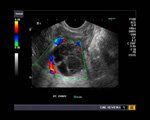
Fishnet or reticular pattern in hemorrhagic ovarian cyst
(Image reproduced with permission from www.ultrasound-images.com )
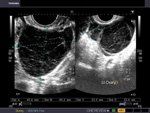
Fine reticular pattern: hemorrhagic ovarian cyst
2) Retracting clot appearance - The process of clot formation and subsequent retraction within the hemorrhagic ovarian cyst results in a triangular and somewhat inhomogenous clot in a part of the cyst with serous fluid occupying the remainder of the cyst.
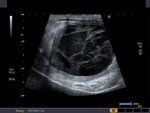
Retracted clot in hemorrhagic ovarian cyst:
3) Fluid debris level in hemorrhagic ovarian cyst - Another sonographic appearance that may be seen is the fluid debris level within the cyst. The debris is formed by sediment or fine particulate elements within the hemorrhagic ovarian cyst.
4) Rupture of hemorrhagic ovarian cyst - An unusual appearance may be caused by rupture of the hemorrhagic ovarian cyst resulting in blood within the pelvis. This is seen as echogenic fluid surrounding the cyst and uterus. If the hemorrhage is severe there may be hemoperitoneum with blood within the Morison pouch. This appearance can mimic an ectopic pregnancy.
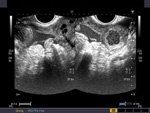
Ruptured hemorrhagic cyst
5) Hemorrhagic ovarian cyst resembling a solid ovarian neoplasm - Another form of hemorrhagic ovarian cyst shows echogenic material within the cyst, which usually happens during the subacute period with early stage of clot formation within the cyst. The sonographic appearance in such cases can mimic a solid ovarian neoplasm. Follow-up sonography will show dramatic changes within the hemorrhagic cyst usually in 4 to 6 weeks. Besides color flow imaging will show lack of flow within the hemorrhagic cyst.
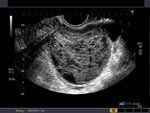
Hemorrhagic ovarian cyst simulating a solid ovarian mass
(Images 2 to 6 are courtesy of Gunjan Puri, MD, India).
Diffferential Diagnosis
Most of the causes of acute pelvic pain can mimic the symptoms and signs of hemorrhagic ovarian cyst. These conditions include acute appendicitis and ectopic pregnancy. Other important differential diagnoses include ovarian torsion, PID (pelvic inflammatory disease) and mesenteric adenitis. Of these, ectopic pregnancy is possibly the most important condition that can mimic hemorrhagic cyst. Serum beta HCG assay with careful examination of the adnexal structures can help distinguish ectopic from hemorrhagic cyst. On probe pressure, the ovary can be seen to move away from the adnexal/ tubal mass in ectopic. The “ring of fire” sign on color Doppler imaging is usually seen in an ectopic pregnancy, but may be also present in hemorrhagic cyst. A positive Beta HCG and pregnancy test can help distinguish ruptured ectopic from ruptured hemorrhagic ovarian cyst.
References:
References:
1) Imaging characteristics of adnexal masses- Lee: (AJR)
2) Ultrasound and CT of pelvic pain - Andrew Potter (radiographics)
3) Imaging of ovarian masses- Jeong- (radiographics)
4) Sonography of hemorrhagic ovarian cysts – Kiran Jain- (J Ultrasound med)
5) http://www.ultrasound-images.com/ovaries.htm (article on hemorrhagic cysts)
S1E4: Dr. Kristina Adams-Waldorf: Pandemics, pathogens and perseverance
July 16th 2020This episode of Pap Talk by Contemporary OB/GYN features an interview with Dr. Kristina Adams-Waldorf, Professor in the Department of Obstetrics and Gynecology and Adjunct Professor in Global Health at the University of Washington (UW) School of Medicine in Seattle.
Listen
Study shows a healthy prenatal diet could be upstream obesity prevention strategy
December 26th 2024"Our findings support the recommendation of a healthy diet based on the current guidelines (as measured by the HEI) during pregnancy, since it may reduce patterns of infant growth outside reference ranges."
Read More
Early pregnancy cannabis use high in states with recreational legalization
November 11th 2024A population-based time-series analysis California before, during and after legalization show a rising trend in women using cannabis while pregnancy especially when the state has legalized the drug.
Read More
